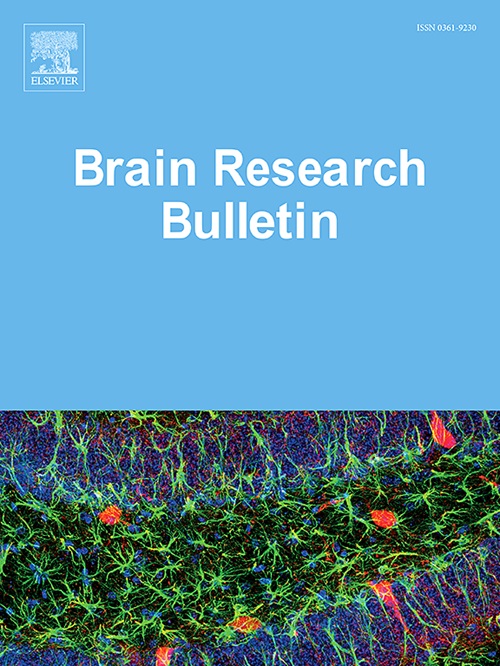Treadmill exercise ameliorates hippocampal synaptic injury and recognition memory deficits by TREM2 in AD rat model
IF 3.5
3区 医学
Q2 NEUROSCIENCES
引用次数: 0
Abstract
Objective
The impairment of cognitive function has been associated with Alzheimer’s disease (AD). Exercise exerts a positive modulatory effect on cognition by reducing synapse injury. However, limited in vivo evidence is available to validate the neuroprotective effect of TREM2 on synaptic function in this phenomenon. Here, we aim to explore whether physical exercise pretreatment alters Aβ-induced recognition memory impairment in structural synaptic plasticity within the hippocampus in AD rats.
Methods:
In study 1, fifty-two Sprague-Dawley (SD) rats were randomly divided into following four groups: control group (C group, n = 13), Alzheimer’s disease group (AD group, n = 13), 4 weeks of physical exercise and Alzheimer’s disease group (Exe+AD group, n = 13), 4 weeks of physical exercise and blank group (Exercise group, n = 13). Four weeks of treadmill exercise intervention was performed, and AD model were established by intra-cerebroventricular injection (ICV) injection of Aβ1–42 protein. After 3 weeks, we also conducted a novel object test to evaluate recognition memory in the behavior assessment. Golgi staining and transmission electron microscopy were used to evaluate the morphology and synaptic ultrastructure of neurons. Western blotting was used to measure the expression of hippocampal synaptic proteins. Extracellular neurotransmitters in the hippocampus were detected by microdialysis coupled with high-performance liquid chromatography. In study 2, 33 SD rats were randomly divided into three groups: 4 weeks of physical exercise and Alzheimer’s disease group (Exe+AD group, n = 11), AAV-Control and physical exercise and Alzheimer’s disease group (AAV-Control+Exe+AD group, n = 11), AAV-TREM2 and physical exercise and Alzheimer’s disease group (AAV-TREM2 +Exe+AD group, n = 11). Stereotactic intracerebral injection in the bilateral hippocampus was performed to achieve microglial TREM2 down-expression by using adeno-associated virus (AAV) with CD68 promoter. After 4 weeks treadmill exercise and 3 weeks Aβ injection, all rats received behavior test and molecular experiment, which the same with experiment 2.
Results
Novel recognition index in novel object recognition test significantly decreased, and western blot demonstrate that hippocampal TREM2 protein is significantly decreased (P < 0.001). But physical exercise reversed this phenomenon(P < 0.001). In addition, compared with Con group, the neuron from Exe+AD group exhibited a more complex branching pattern (P < 0.05). And impaired synaptic ultrastructure was observed in AD group. Hippocampal synaptic-related protein (SYX, SYP, GAP43, PSD95) and neurotransmitter (DA, Glu, GABA) was also significantly decreased (P < 0.01) in AD group. But the neuroprotection effect can be found in Exe+AD group, which are associated with the inhibition of synaptic injury by activate hippocampal TREM2 (P < 0.05). However, when blockade of hippocampal TREM2 reduced brain protective effect of exercise in AD rat model, including increased the damage of neuronal dendritic complexity, synaptic ultrastructure, and the decrease of hippocampal synapses-related protein, typical neurotransmitter.
Conclusion
Treadmill exercise facilitated recognition memory acquisition via TREM2-mediated structural synaptic plasticity of the hippocampus in an AD rat model.
跑步机运动可通过TREM2改善AD大鼠海马突触损伤和识别记忆缺陷。
目的:认知功能障碍与阿尔茨海默病(AD)有关。运动通过减少突触损伤对认知产生正向调节作用。然而,在这种现象中,体内证据有限,无法验证TREM2对突触功能的神经保护作用。本研究旨在探讨体育锻炼预处理是否能改变a β诱导的AD大鼠海马结构突触可塑性的识别记忆障碍。方法:在研究1中,将52只SD大鼠随机分为4组:对照组(C组,n=13)、阿尔茨海默病组(AD组,n=13)、4周体育锻炼和阿尔茨海默病组(Exe+AD组,n=13)、4周体育锻炼和空白组(运动组,n=13)。采用跑步机运动干预4周,通过脑室注射Aβ1-42蛋白建立AD模型。3周后,我们还进行了新的对象测试来评估行为评估中的识别记忆。采用高尔基染色和透射电镜观察神经元的形态和突触超微结构。Western blotting检测海马突触蛋白表达。采用微透析联用高效液相色谱法检测海马细胞外神经递质。研究2将33SD大鼠随机分为3组:4周体育锻炼与阿尔茨海默病组(Exe+AD组,n=11)、AAV-Control与体育锻炼与阿尔茨海默病组(AAV-Control+Exe+AD组,n=11)、AAV-TREM2与体育锻炼与阿尔茨海默病组(AAV-TREM2+Exe+AD组,n=11)。采用带CD68启动子的腺相关病毒(adeno-associated virus, AAV)在双侧海马进行立体定向脑内注射,实现小胶质细胞TREM2的下调表达。各组大鼠在4周的跑步机运动和3周的Aβ注射后进行行为学测试和分子实验,与实验2相同。结果:新物体识别测试中的新识别指数显著降低,western blot结果显示海马TREM2蛋白显著降低(p)。结论:跑步机运动通过TREM2介导的海马结构突触可塑性促进AD模型大鼠海马识别记忆习得。
本文章由计算机程序翻译,如有差异,请以英文原文为准。
求助全文
约1分钟内获得全文
求助全文
来源期刊

Brain Research Bulletin
医学-神经科学
CiteScore
6.90
自引率
2.60%
发文量
253
审稿时长
67 days
期刊介绍:
The Brain Research Bulletin (BRB) aims to publish novel work that advances our knowledge of molecular and cellular mechanisms that underlie neural network properties associated with behavior, cognition and other brain functions during neurodevelopment and in the adult. Although clinical research is out of the Journal''s scope, the BRB also aims to publish translation research that provides insight into biological mechanisms and processes associated with neurodegeneration mechanisms, neurological diseases and neuropsychiatric disorders. The Journal is especially interested in research using novel methodologies, such as optogenetics, multielectrode array recordings and life imaging in wild-type and genetically-modified animal models, with the goal to advance our understanding of how neurons, glia and networks function in vivo.
 求助内容:
求助内容: 应助结果提醒方式:
应助结果提醒方式:


